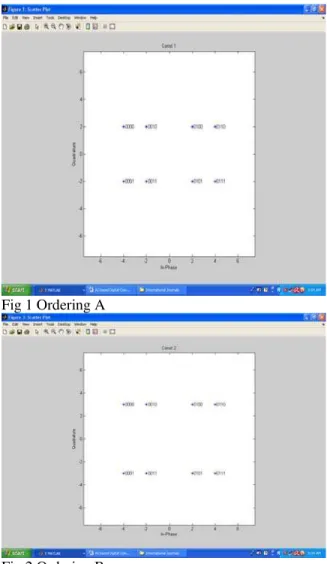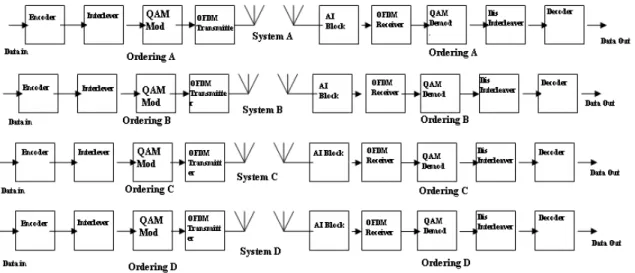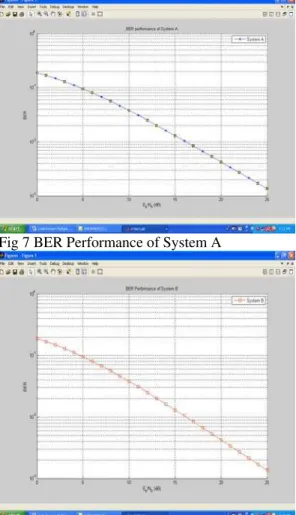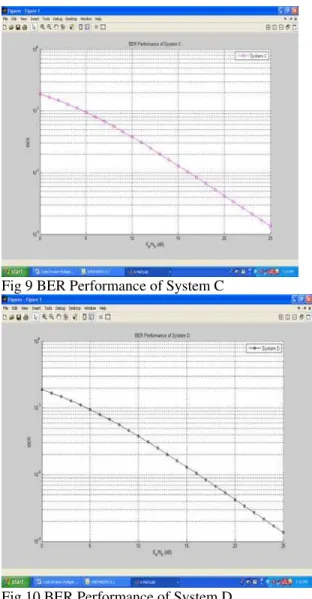Code Division Multiplexing Using AI
Based Custom Constellation Scheme –
Efficient Modulation for High Data rate
Transmission
K.SESHADRI SASTRY*
Research scholar,
Department of computer science & systems Engineering, Andhra University,
Visakhapatnam. Email:aditya_shas@yahoo.com
DR.M.S.PRASAD BABU
Professor,
Department of computer science & systems Engineering, Andhra University,
Visakhapatnam.
Abstract - To achieve high bit rate in transmission over wireless channels frequency reuse is an encouraging concept . Rather than dividing allocated frequency spectrum into narrow band width channels , one for each user information is transmitted over a very wide frequency spectrum using the same carrier frequency within same frequency band . In this paper we propose code division multiplexing scheme in which Custom QAM modulator itself is used as code . The propose system is simulated and tested in Matlab 7.4
Key words- CDM, OFDM ,Artificial Intelligence ,QAM
1.Introduction
Future wireless services including internet and real-time video will continue to increase the required data rates for wireless communication systems. This paper investigates modulation formats for high data rate applications in wireless environments. In particular, we consider situations where the delay spread of the channel is long compared to the bit duration. Highly dispersive channels cause significant inter-symbol interference (ISI), but they also offer a substantial potential for performance improvement through diversity. Traditional single carrier modulation formats such as phase shift keying (PSK), frequency shift keying (FSK), and quadrature amplitude modulation (QAM) require significant equalization to perform adequately in a highly dispersive
channel.
In this paper, we present code division multiplexing (CDM) as an alternative modulation format to the above
users share the channel by using orthogonal frequency slots. In the case of OFDM, it is not different users sharing the channel but rather different data bits being transmitted in parallel. The single carrier modulation formats are analogous to TDMA systems where different users transmit their bits in orthogonal time slots. With PSK, FSK, and QAM, the different bits are transmitted in orthogonal time slots as well
This modulation format which we propose is not new. It is a special case of parallel combinatory spread spectrum multiple access [ l ] and also a special case of multi-code CDMA [2], [3]. In these cases, the technique is used to enhance CDMA systems, whereas in our work, we are considering CDM as a single-user modulation format. A similar technique is used in [4], but we will demonstrate a much higher spectral efficiency than was achieved in that work
This paper is organized as follows Section 2 explains Proposed scheme section 2.1 explains AI block ,section 3 explains results and section 4 concludes paper.
2. Proposed Scheme
Proposed scheme uses custom constellation ordering of QAM modulator as code . It uses 8 QAM , the same carrier frequency within same frequency band can be used for four wireless systems. In the proposed scheme four custom constellation orderings which were shown in Fig 1 , 2, 3 4 are used . Every constellation ordering differs from other in arrangement of quadrature and phase component. For every wireless system a fixed code is given. ( i.e. for system A ordering A is employed , for system B ordering B is employed , for system C ordering C is employed , for system D ordering D is employed ) as shown in table 1 . Block diagram of proposed system is shown in Fig 5.
Fig 1 Ordering A
The proposed system is simulated in Matlab 7.4 . The parameters of OFDM system used are as follows, IFFT Size is 512 , Number of sub carriers are 512 , Number of sub bands are 32 , Number of sub carriers per sub band are 16 , Guard Time Duration is 128 , Frame size is 6 , 8 QAM Modulation scheme , convolutional coder with code rate 2/3 , Bandwidth 5MHz , Carrier Frequency 2 GHz , Sampling Frequency 5.4MHz
Fig 3 Ordering C
Fig 4 Ordering D
SNO System Constellation Ordering
1 System A Ordering A 2 System B Ordering B 3 System C Ordering C 4 System D Ordering D
Table 1 Code allocation
demodulator otherwise signal is blocked . So signals transmitted by system A transmitter is received by receiver of system A only . For receiver of System A signals transmitted by System B , C and D are blocked (treated as noise ) . So even though same carrier frequency within same frequency band is used by four wireless systems , information transmitted for system A is received by System A , information transmitted for System B is received by system B , information transmitted for System C is received by System C and information transmitted for System D is received by System D. So by using the proposed scheme same carrier frequency within same frequency band can used by four wireless systems i.e. frequency is reused which leads to high bit rate in transmission over wireless channels.
Fig 5 Proposed System
2.1 AI Based Block
Block diagram of AI (Artificial Intelligent) Block is shown in Fig 6 . AI block checks the code of incoming signal and if code matches signal is transmitted , otherwise signal is blocked .
Fig 6 AI Block
Incoming signal is divided to real part and imaginary part (real part consists of Phase component and imaginary part consists of Quadrature component ) . AI block of every system is designed for a specific code . For example AI block of System A is designed for ordering A , AI block of System B is designed for ordering B and so on ( as shown in Table 1) . i.e. ordering A consists of
quadrature components 1 ,-1. Ordering D consists of Phase components -4,-2 ,2 ,4 and quadrature components 4 ,-4. So every ordering differs from other based on arrangement of quadrature and phase components.
AI block compares the incoming signals quadrature and phase components and if quadrature and phase components of the incoming signal matches then the signal is allowed to pass to the naxt section of receiver , otherwise it is blocked. ( For example in System A if the incoming signals quadrature component is 2 or -2 and phase component is -4 or --2 or -2 or 4 then the signal is allowed to pass to next section otherwise signal is blocked.)
3.Results
Proposed system is simulated and verified in Matlab 7.4 . Even though same carrier frequency within same frequency band is used by four wireless systems , information transmitted for system A is received by System A , information transmitted for System B is received by system B , information transmitted for System C is received by System C and information transmitted for System D is received by System D. So by using the proposed scheme same carrier frequency within same frequency band can used by four wireless systems i.e. frequency is reused which leads to high bit rate in transmission over wireless channels. BER (Bit Error Rate ) Performance of four systems is shown in Fig 7 , 8 ,9 and 10
Fig 7 BER Performance of System A
Fig 9 BER Performance of System C
Fig 10 BER Performance of System D
Fig 11 shows the comparison of system which uses proposed scheme and system which do not uses proposed scheme (traditional system) . System which do not uses proposed scheme uses four types of carrier frequencies and system uses proposed scheme uses only one type of carrier frequency . Proposed scheme is superior to existing Code Division Multiplexing systems due to following reasons. System using proposed scheme do not require Pilot signal and System using Proposed scheme do not include code in information to be transmitted (which decreases either speed of transmission or Bit Error Rate of system)
4. Conclusion
Using proposed scheme allows to use same carrier frequency within same frequency band for upto four wireless systems which allows High Data rate transmission without compromising in Bit Error Rate of System .
References
[1] S. Sasaki, J. Zhu and G. Marubayashi, “Performance of parallel combinatory spread spectrum multiple access communication systems,” Proceedings of 1991 IEEE International Symposium on Personal, Indoor and Mobile Radio Communications
(PIMRC), pp. 204-208.
[2] G. P. Pollini, L. Ozarow and R. D. Gitlin, “Performance of multi-code CDMA wireless personal communications networks,”
Proceedings of 1995 IEEE Vehicular Technology Conference, pp. 907-911
[3] D. Koulakiotis and A. H. Aghvami, ‘‘Performance enhancement of multi-code CDMA using interference cancellatioin,”
Proceedingsof 1998 IEEE International Symposium on Spread SpectrumTechniques and Applications, pp. 130- 134.
[4] H. Hiroshi, G. W. Kazumasa, Y. Hase and H. Sasaoka, “A new multi-code high speed mobile radio transmission scheme using cyclic modified m-sequence,” Proceedings of 1997 IEEE VehicularTechnology Conference, pp. 1709-1713.
[5] J. G. Proakis,Digital Communication 3rd edition , McGraw-Hill, 1995.
[6] D. Divsalar, M. K. Simon and D. Raphaeli, “Improved parallel interference cancellation for CDMA,” IEEE Transactions on
Communications, vol. 46., no. 2, pp. 258-268, Feb. 1998.




